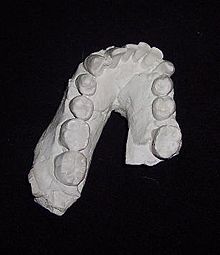OH 7 (Olduvai Hominid № 7), also nicknamed "Johnny's Child",[1] is the type specimen of Homo habilis. The fossils were discovered on November 4, 1960 in Olduvai Gorge, Tanzania, by Jonathan and Mary Leakey. The remains are dated to approximately 1.75 million years, and consist of fragmented parts of a lower mandible (which still holds thirteen teeth, as well as unerupted wisdom teeth), an isolated maxillary molar, two parietal bones, and twenty-one finger, hand, and wrist bones.[2]
 | |
| Catalog no. | OH 7 |
|---|---|
| Species | Homo habilis |
| Age | 1.75 million years |
| Place discovered | Olduvai Gorge, Tanzania |
| Date discovered | November 4, 1960 |
| Discovered by | Jonathan Leakey |
The OH 7 hand is wide, with a large thumb and broad fingertips, similar to that of humans; however, unlike in humans the fingers are relatively long and exhibit chimpanzee-like curvature. Furthermore, the thumb's orientation relative to the other fingers resembles the anatomy of great apes.[3] The parietal bones — a nearly complete left parietal and fragmented right parietal — were used to deduce the cranial capacity of the hominid, which was placed at 663 cc in account of the fact that the fossils belonged to a 12- or 13-year-old male. This was extrapolated by Phillip Tobias to 674 cc for the hominid's full adult potential.[4] However, other scientists have estimated the cranial capacity at 590 cc[5] to 710 cc.[6]
Louis Leakey, John Napier, and Phillip Tobias were among the first to extensively study the fossils. The Leakey team and others argued that, due expanded cranial capacity,[4] gnathic reduction, relatively small post-canine teeth (compared to Paranthropus boisei),[7] Homo-like pattern of craniofacial development,[8] and a precision grip in the hand fragments (which indicated the ability for tool use), set OH 7 apart as a transitional species between Australopithecus africanus and Homo erectus.
The Leakey team announced the new species Homo habilis in the April 1964 issue of Nature,[9] igniting debate among the anthropology community which lasted through the 1970s. As early as May 1964, Kenneth Oakley and Bernard Campbell had raised concerns about the Leakey team's findings with their own publication in Nature, and in July of that same year Sir Wilfrid Le Gros Clark bluntly stated his hope that H. habilis "will disappear as rapidly as he came."[1] The controversy and bias against the newly named species lead some anthropologists to refer to H. habilis as Australopithecus habilis or assign associated fossil remains to other Homo species, a trend that continued long after Le Gros Clark's death in 1971.[10]
Other critics noted that OH 7 was found in a region known to contain P. boisei fossils, was of an immature individual, and that the differences between H. habilis and P. boisei were not enough to warrant a new species. Some believe OH 7 more closely resembles A. africanus.
See also edit
- List of fossil sites (with link directory)
- List of hominina (hominid) fossils (with images)
References edit
- Footnotes
- ^ a b Sawyer et al. 2007, p. 130.
- ^ Lieberman, Wood & Pilbeam 1996, pp. 4–6
- ^ Sawyer et al. 2007, p. 124.
- ^ a b Tobias 1971
- ^ Wolpoff 1999
- ^ Holloway 1966, pp. 1108–1109
- ^ Vandebroek 1969
- ^ Bromage 1989
- ^ Leakey, Tobias & Napier 1964, pp. 79
- ^ Sawyer et al. 2007, pp. 129–30.
- Bibliography
- Sawyer, Gary J.; Deak, Viktor.; Sarmiento, Esteban.; Milner, Richard (2007). The Last Human: A Guide to Twenty-Two Species of Extinct Humans. New Haven, CT: Yale University Press. pp. 256. ISBN 978-0-300-10047-1.
In a 1964 April issue of Nature, Louis Leakey, Phillip Tobias, and Napier described the new species H. Habilis, designating OH 7, nicknamed "Johnny's Child" (a lower jaw without erupted wisdom teeth and associated skull fragments, hand bones, and an upper molar), as the holotype specimen.
- Bromage, Timothy G. (1989). "Ontogeny of the early hominid face". Journal of Human Evolution. 18 (8): 751–773. doi:10.1016/0047-2484(89)90088-2.
- Holloway, Ralph L. (1966). "Cranial capacity of the Olduvai Bed I hominine". Nature. 210 (5041): 1108–1109. Bibcode:1966Natur.210.1108H. doi:10.1038/2101108a0. S2CID 4151806.
- Leakey, Louis; Tobias, Phillip V.; Napier, John Russell (1964). "A New Species of the Genus Homo from Olduvai Gorge" (PDF). Nature. 202 (4927): 7–9. Bibcode:1964Natur.202....7L. doi:10.1038/202007a0. PMID 14166722. S2CID 12836722.
- Lieberman, Daniel E.; Wood, Bernard A.; Pilbeam, David R. (1996). "Homoplasy and early Homo: an analysis of the evolutionary relationships of H. habilis sensu stricto and H. rudolfensis" (PDF). Journal of Human Evolution. 30 (2): 4–6. doi:10.1006/jhev.1996.0008.
- Tobias, Phillip V. (1971). "The Brain in Hominid Evolution". American Journal of Physical Anthropology. 39 (1). New York, NY: Columbia University Press.: 137–139. doi:10.1002/ajpa.1330390115.
- Vandebroek, Georges (1969). Évolution des Vertébrés de leur Origine à l'Homme. Paris: Masson et Cie.
- Wolpoff, Milford H. (1999). Paleoanthropology (2nd ed.). Boston, MA: McGraw-Hill. ISBN 0-07-071676-5.
External links edit
- Media related to OH 7 at Wikimedia Commons